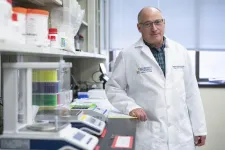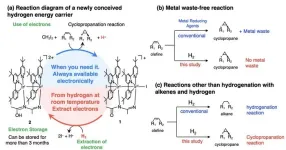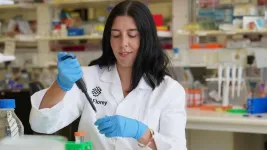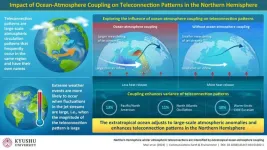(Press-News.org) Familial Alzheimer’s disease can be transferred via bone marrow transplant, researchers show March 28 in the journal Stem Cell Reports. When the team transplanted bone marrow stem cells from mice carrying a hereditary version of Alzheimer’s disease into normal lab mice, the recipients developed Alzheimer’s disease—and at an accelerated rate.
The study highlights the role of amyloid that originates outside of the brain in the development of Alzheimer’s disease, which changes the paradigm of Alzheimer’s from being a disease that is exclusively produced in the brain to a more systemic disease. Based on their findings, the researchers say that donors of blood, tissue, organ, and stem cells should be screened for Alzheimer’s disease to prevent its inadvertent transfer during blood product transfusions and cellular therapies.
“This supports the idea that Alzheimer's is a systemic disease where amyloids that are expressed outside of the brain contribute to central nervous system pathology,” says senior author and immunologist Wilfred Jefferies, of the University of British Columbia. “As we continue to explore this mechanism, Alzheimer’s disease may be the tip of the iceberg and we need to have far better controls and screening of the donors used in blood, organ and tissue transplants as well as in the transfers of human derived stem cells or blood products.”
To test whether a peripheral source of amyloid could contribute to the development of Alzheimer’s in the brain, the researchers transplanted bone marrow containing stem cells from mice carrying a familial version of the disease—a variant of the human amyloid precursor protein (APP) gene, which, when cleaved, misfolded and aggregated, forms the amyloid plaques that are a hallmark of Alzheimer’s disease. They performed transplants into two different strains of recipient mice: APP-knockout mice that lacked an APP gene altogether, and mice that carried a normal APP gene.
In this model of heritable Alzheimer’s disease, mice usually begin developing plaques at 9 to 10 months of age, and behavioral signs of cognitive decline begin to appear at 11 to 12 months of age. Surprisingly, the transplant recipients began showing symptoms of cognitive decline much earlier—at 6 months post-transplant for the APP-knockout mice and at 9 months for the “normal” mice.
“The fact that we could see significant behavioral differences and cognitive decline in the APP-knockouts at 6 months was surprising but also intriguing because it just showed the appearance of the disease that was being accelerated after being transferred,” says first author Chaahat Singh of the University of British Columbia.
In mice, signs of cognitive decline present as an absence of normal fear and a loss of short and long-term memory. Both groups of recipient mice also showed clear molecular and cellular hallmarks of Alzheimer’s disease, including leaky blood-brain barriers and buildup of amyloid in the brain.
Observing the transfer of disease in APP-knockout mice that lacked an APP gene altogether, the team concluded that the mutated gene in the donor cells can cause the disease and observing that recipient animals that carried a normal APP gene are susceptible to the disease suggests that the disease can be transferred to health individuals.
Because the transplanted stem cells were hematopoietic cells, meaning that they could develop into blood and immune cells but not neurons, the researchers’ demonstration of amyloid in the brains of APP knockout mice shows definitively that Alzheimer’s disease can result from amyloid that is produced outside of the central nervous system.
Finally the source of the disease in mice is a human APP gene demonstrating the mutated human gene can transfer the disease in a different species.
In future studies, the researchers plan to test whether transplanting tissues from normal mice to mice with familial Alzheimer’s could mitigate the disease and to test whether the disease is also transferable via other types of transplants or transfusions and to expand the investigation of the transfer of disease between species.
“In this study, we examined bone marrow and stem cells transplantation. However, next it will be important to examine if inadvertent transmission of disease takes place during the application of other forms of cellular therapies, as well as to directly examine the transfer of disease from contaminated sources, independent from cellular mechanisms,” says Jefferies.
###
This research was supported by the Canadian Institutes of Health Research, the W. Garfield Weston Foundation/Weston Brain Institute, the Centre for Blood Research, the University of British Columbia, the Austrian Academy of Science, and the Sullivan Urology Foundation at Vancouver General Hospital.
Stem Cell Reports, Singh et al., “Conclusive Demonstration of Iatrogenic Alzheimer’s Disease Transmission in a Model of Stem Cell Transplantation” https://www.cell.com/stem-cell-reports/fulltext/S2213-6711(24)00049-3
Stem Cell Reports (@stemcellreports), published by Cell Press for the International Society for Stem Cell Research (@ISSCR), is a monthly open-access forum communicating basic discoveries in stem cell research, in addition to translational and clinical studies. The journal focuses on shorter, single-point manuscripts that report original research with conceptual or practical advances that are of broad interest to stem cell biologists and clinicians. Visit http://www.cell.com/stem-cell-reports. To receive Cell Press media alerts, please contact press@cell.com.
END
About The Study: In this survey study of 204 oncologists, few reported that patients needed to understand artificial intelligence (AI) models, but most agreed that patients should consent to their use, and many tasked patients with choosing between physician- and AI-recommended treatment regimens. These findings suggest that the implementation of AI in oncology must include rigorous assessments of its effect on care decisions as well as decisional responsibility when problems related to AI use arise.
Authors: Gregory A. Abel, M.D., M.P.H., of the Dana-Farber Cancer Institute in Boston, is the corresponding author.
To ...
About The Study: From 2013 to 2022, U.S. physicians received $12.1 billion from industry. More than half of physicians received at least one payment. Payments varied widely between specialties and between physicians within the same specialty. A small number of physicians received the largest amounts, often exceeding $1 million, while the median physician received much less, typically less than a hundred dollars.
Authors: Andrew J. Foy, M.D., of the Penn State Milton S. Hershey ...
BOSTON -- Andrew E. Place, MD, PhD, has been named as Vice President, Pediatric Chief Medical Officer (CMO) at Dana-Farber Cancer Institute (within the Department of Pediatric Oncology) and Boston Children’s Hospital (within the Division of Hematology/Oncology) for the Dana-Farber/Boston Children’s Cancer and Blood Disorders Center.
In this role, Place will work closely with institutional and departmental leaders at Boston Children’s Hospital (BCH) and Dana-Farber to help define and implement clinical strategies and operational approaches that enhance smooth and efficient running of clinical care ...
UVA Health researchers have discovered a potential explanation for some of the most perplexing mysteries of COVID-19 and long COVID. The surprising findings could lead to new treatments for the difficult acute effects of COVID-19, long COVID and possibly other viruses.
Researchers led by UVA’s Steven L. Zeichner, MD, PhD, found that COVID-19 may prompt some people’s bodies to make antibodies that act like enzymes that the body naturally uses to regulate important functions – blood pressure, for example. Related enzymes also regulate ...
Just as many people battle seasonal colds and flu, native plants face their own viral threats. People have long known that plants can succumb to viruses just like humans. Now, a new study led by Michigan State University and the University of California, Riverside reveals a previously unknown threat: non-native crop viruses are infecting and jeopardizing the health of wild desert plants.
“For years, the ecological field assumed wild plants were immune to invasive viruses that damage crops,” said Carolyn ...
Fukuoka, Japan—Researchers from Kyushu University have developed a hydrogen energy carrier to address some of the biggest hurdles in the path towards a sustainable hydrogen economy. As explained in a paper published in JACS Au, this novel compound can efficiently “store electrons” from hydrogen in a solid state to use in chemical reactions later.
Hydrogen is a promising source of clean energy with a lot of untapped potential applications in industry and everyday life. Unlike conventional fuels, hydrogen can be used to generate electricity without producing greenhouse ...
Scientists at The Florey have developed an mRNA technology approach to target the toxic protein tau, which builds up in patients with Alzheimer’s disease and other dementias.
To date, mRNA has been predominantly used for vaccines, including those used to fight COVID-19.
New research published today in Brain Communications establishes The Florey as a key player in the mRNA field, with Dr Rebecca Nisbet taking the technology in a new direction.
“This is the first time mRNA has been explored for use in Alzheimer’s disease,” Dr Nisbet said. “Our work in cell models demonstrates that this technology ...
East Hanover, NJ – March 28, 2024 – Kessler Foundation received two grants from The New Jersey Commission on Spinal Cord Research that will fuel innovative research in the field of spinal cord injury (SCI). These grants will fund efforts aimed at improving the cognitive assessment of individuals with traumatic SCI and pilot-testing the first-of-its-kind Spinal Cord Injury Personal Assistance Services Survey (SCI-PASS).
Traumatic spinal cord injury (tSCI) often leads to cognitive impairment, affecting up to 60 percent of individuals living with this condition. “The challenge lies in assessing cognitive functions in people with tSCI, as many existing tests rely on upper limb ...
Rising temperatures and disease outbreaks are decimating coral reefs throughout the tropics. Evidence suggests that higher latitude marine environments may provide crucial refuges for many at-risk, temperature-sensitive coral species. However, how coral populations expand into new areas and sustain themselves over time is constrained by the limited scope of modern observations.
What can thousands of years of history tell us about what lies ahead for coral reef communities? A lot. In a new study, Florida Atlantic University researchers and collaborators provide geological insights into coral range expansions by reconstructing the composition of a Late Holocene-aged subfossil coral ...
Fukuoka, Japan—The interaction between the oceans and the atmosphere plays a vital role in shaping the Earth’s climate. Changing sea surface temperatures can heat or cool the atmosphere, and changes in the atmosphere can do the same to the ocean surface. This exchange in energy is known as “ocean-atmosphere coupling.”
Now, researchers from Kyushu University have revealed that this ocean-atmosphere coupling enhances teleconnection patterns—when climate conditions change across vast regions of the globe—in the Northern Hemisphere. In their recent ...







